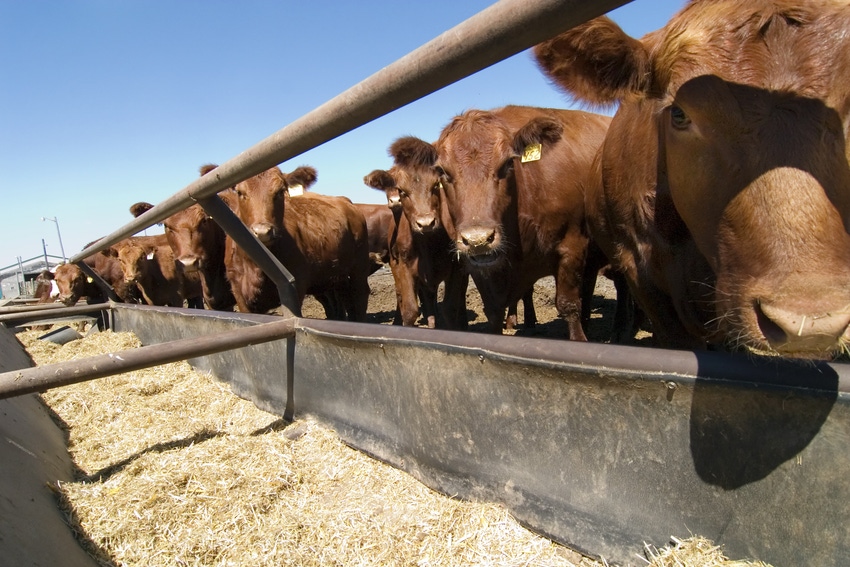USDA releases key cattle, hog reports
Both reports mostly in line with analysts' pre-report expectations.

The U.S. Department of Agriculture released two key reports this week for both the cattle and hog sectors. The quarterly "Hogs & Pigs" report came in near analysts' pre-report expectations. The "Cattle on Feed" report also was mostly in line with pre-report estimates, except for placements, which were lower than anticipated.
According to USDA, the U.S. inventory of all hogs and pigs on Dec. 1 was 74.6 million head, a 2% increase from Dec. 1 but a 1% decline from Sept. 1. The trade was expecting a 2.7% increase.
Breeding inventory came in at 6.33 million head, which USDA reported was up 2% from last year but down slightly from the previous quarter. The trade had expected a 2.9% increase.
Market hog inventory, at 68.2 million head, was 2% higher than last year but 1% lower than last quarter. The trade was expecting a 2.7% increase over last year.
USDA reported that the September to November 2018 pig crop, at 34.0 million head, was up 2% from 2017. Sows farrowing during this period totaled 3.16 million head, also up 2% from 2017. The sows farrowed during this quarter represented 50% of the breeding herd, USDA noted. The average pigs saved per litter was a record high of 10.76 for the September to November period, compared to 10.74 last year.
In terms of farrowing intentions, USDA reported that U.S. hog producers intend to farrow 3.11 million sows during the December 2018 through February 2019 quarter, a 2% increase from the actual farrowings during the same period in 2018 and a 4% increase from 2017. Intended farrowings for March to May 2019, at 3.15 million sows, are up 2% from 2018 and up 4% from 2017.
During a conference call hosted by the National Pork Board, Altin Kalo, analyst with Steiner Consulting Group, said his calculations suggest that producers have reduced the number of gilts retained by about 3%. “It’s a little hard to say whether that’s going to be the trend going forward and whether that reflects some of the challenges that producers have faced in the last three months or so,” Kalo said.
He also noted that USDA’s farrowing numbers seem to be a little high.
“For several quarters, we’ve had farrowing intentions come on the lower end. I think this is actually a little bit higher than I would have expected, especially if we look at the trend in recent quarter,” he explained.
USDA reported the total number of hogs under contract owned by operations with more than 5,000 head but raised by contractees accounted for 47% of the total U.S. hog inventory, unchanged from the previous year.
USDA did revise some numbers from past reports. The September 2018 all hogs and pigs inventory was revised by 0.7%. The net revision made to the June 2018 all hogs and pigs inventory was 0.8%. A revision of 0.7% was made to the March to May 2018 pig crop. The net revision made to the March 2018 all hogs and pigs inventory was 0.2%. A net revision of 0.7% was made to the December 2017 to February 2018 pig crop. The net revision made to December 2017 all hogs and pigs inventory was 0.3%. A net revision of less than 0.1% was made to the September through November 2017 pig crop.
Overall, Kalo called the report “a little bit friendly” to the market as the numbers were all mostly under what the trade had expected.
Using the Iowa/Minnesota hog price, Kalo provided his forecasts: $61/cwt. for the first quarter of 2019, $72/cwt. for the second quarter, $74/cwt. for the third quarter and $59/cwt. for the fourth quarter.
Independent analyst Bob Brown also provided his projections on the Pork Board call. Using the CME lean hog futures price, he projected the first quarter of 2019 at $63/cwt., the second quarter at $72/cwt., the third quarter at $71/cwt. and the fourth quarter at $62/cwt.
Jim Robb, center director and senior agricultural economist at the Livestock Marketing Information Center, used the national weighted base price to make his forecasts of $62-64/cwt. for the first quarter of 2019, $68-71/cwt. for the second quarter, $63-67/cwt. for the third quarter and $57-62/cwt. for the fourth quarter.
Feedlot cattle inventory rises
USDA also released its monthly "Cattle on Feed" report Thursday, which showed that total inventory in the U.S. for feedlots with capacity of 1,000 head or more totaled 11.7 million head on Dec.1, a 2% increase from Dec. 1, 2017. This was in line with pre-report estimates.
Placements in feedlots during November totaled 2.00 million head, 5% less than in 2017. The trade was expecting a 6% decline in placements.
Rich Nelson, chief strategist for Allendale Inc., said this now marks three months in a row of below-year-ago placements. This, he explained, does set up the summer of 2019 with perhaps a little bit better supply picture than was originally expected. However, the report overall was neutral to slightly disappointing.
Net placements were 1.92 million head. During November, placements of cattle and calves were 550,000 head for those weighing less than 600 lb., 495,000 head for those weighing 600-699 lb., 416,000 head for those weighing 700-799 lb., 315,000 head for those weighing 800-899 lb., 115,000 head for those weighing 900-999 lb. and 105,000 head for those weighing 1,000 lb. and greater.
Marketings of fed cattle during November totaled 1.87 million head, 1% above 2017 and in line with expectations. USDA said marketings were also the highest for November since the series began in 1996.
Other disappearance totaled 80,000 head during November, 13% above 2017.
About the Author(s)
You May Also Like




.png?width=300&auto=webp&quality=80&disable=upscale)
